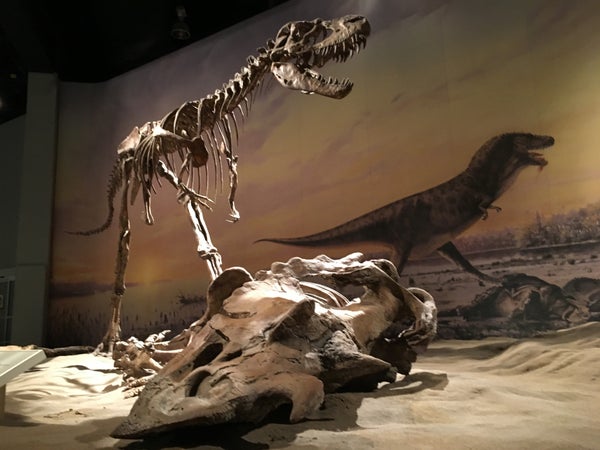This article was published in Scientific American’s former blog network and reflects the views of the author, not necessarily those of Scientific American
I’ve written plenty about the damage theropod dinosaurs inflicted on bones lately. But this is looking at the way Mesozoic carnivores fed from the ground up, so to speak, starting with assaulted elements and working backwards. What can the maws of predatory dinosaurs themselves tell us about the way they fed? That’s the question at the center of
a new study by paleontologist Angelica Torices and colleagues.
Picking out carnivorous dinosaurs in the fossil record isn’t a huge challenge. Their teeth look like knives, often compressed from side to side, recurved, and serrated along the cutting edges. These were clearly for puncturing and cutting meat, not leaves. Likewise, we know that carnivorous theropods couldn’t gnaw or chew the way that modern carnivores do. Theropod jaws were essentially giant pairs of scissors, great for slicing but generally not for breaking down morsels into smaller pieces. Yet, beyond these broad strokes, we don’t know very much about how these dinosaurs fed. To that end, Torices and coauthors looked to the teeth of several coelurosaurs - from the giant tyrannosaur Gorgosaurus to the small Dromaeosaurus, Saurornitholestes, and “Troodon” - to see what microscopic damage and reactions to physical stress could reveal about feeding behavior.
On supporting science journalism
If you're enjoying this article, consider supporting our award-winning journalism by subscribing. By purchasing a subscription you are helping to ensure the future of impactful stories about the discoveries and ideas shaping our world today.
Despite difference in size and skull anatomy, the similar biomechanical makeup of these dinosaurs’ jaws created similar scratches. All of the teeth in the study, regardless of size or species affiliation, showed scratches running parallel to the long axis of the tooth as well as scratches running at an angle to the cutting edge. “There are no differences in the microwear patterns on large and small theropods,” Torices and colleagues write, “and therefore, biting movements must have been similar across the taxa we studied.”
And what were those movements? The microscopic damage seems to be consistent with a “puncture-and-pull-style motion,” the researchers write, the teeth sinking in vertically and then moving back at an oblique angle as the dinosaurs closed their jaws or pulled their heads backward to yank out a mouthful of flesh. Finite element analysis - an engineering technique that determines where an object suffers stress - backed up this analysis, with the studied teeth seeming best adapted to puncture-pull feeding.
But this isn’t to say that these dinosaurs were making the same menu choices. Aside from different body sizes, the studied teeth differed in the number, size, and shape of the denticles that make up the cutting edges of the teeth. “Troodon” teeth, for example, have large, hooked denticles, yet the stress analysis suggested that these would have been a liability with struggling prey - they would have propagated stress through the tooth, making it more likely to break. Big prey that fought back was unlikely for "Troodon." Following previous research, this might indicate that “Troodon” primarily targeted small prey and had a more cosmopolitan diet than other dinosaurs that subsisted chiefly on flesh.
Further testing is needed, as ever, but it would seem that the puncture-pull method came standard for carnivorous theropods. Despite differences in shape and serration count, the teeth of these dinosaurs were best suited to sinking into flesh and cutting backwards, whether we’re talking about Velociraptor or Allosaurus. This stands in stark contrast to the bestial carnivores we know today, varied toolkits of teeth scattering wolves, bears, big cats, hyenas, and more along a spectrum of hypercarnivory to omnivory and even herbivory. And if the conclusions of this study hold, it only further underscores the bizarre nature of Mesozoic environments like those preserved in the Morrison Formation, where multiple large carnivorous dinosaurs have been found in the same deposits. What differentiated them, and what allowed them all to find prey suitable to their tastes and abilities, has to go deeper than their terrible teeth.
